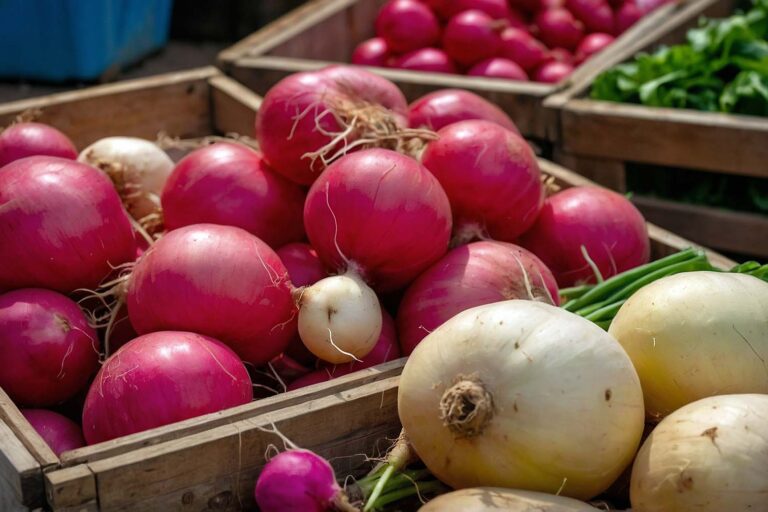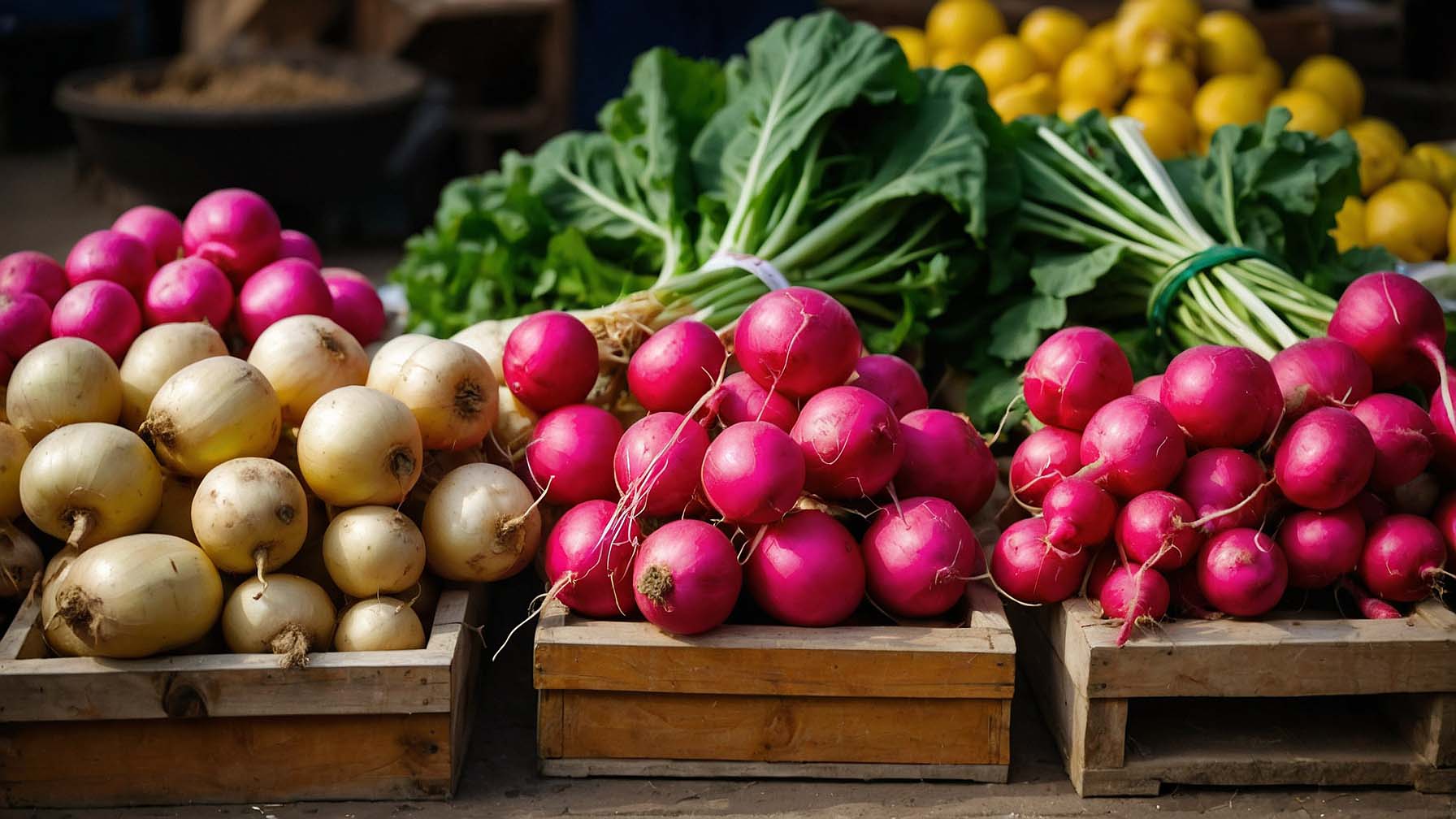Turnips and radishes are both root vegetables, yet they vary in taste and texture. Turnips are generally larger and have a milder flavor compared to the peppery taste of smaller radishes.
Root vegetables are a staple in many diets, offering not just versatility in cooking but also a wealth of nutritional benefits. Turnips, with their white flesh and slight bitterness, are often used in stews and can be eaten both raw and cooked.
Roots on the Table: Turnips and Radishes

Exploring the vibrant world of root vegetables, turnips and radishes offer flavors, textures, and nutrition that can be hard to resist. These underground gems have a lot in common but also their own unique charm. With their crisp bite and peppery to sweet notes, they make a worthy addition to any meal. Let’s dive into the diversity and richness of these two root heroes.
Cultural Significance
Turnips and radishes carry a hefty legacy in many cultures. Across the globe, they symbolize growth, renewal, and health.
- Turnips are carved into lanterns during Samhain, celebrating the harvest’s end.
- Radishes star in the Oaxaca festival ‘Night of the Radishes’, showing creativity and tradition.
In stories, these roots often stand for simplicity and grounding. They serve as a humble reminder of the earth’s bounty.
Culinary Uses Globally
Turnips and radishes grace tables worldwide, transformed through local culinary magic. Here are some global dishes using these roots:
| Country | Vegetable | Dish |
|---|---|---|
| Japan | Radish | Daikon in sushi and pickles |
| India | Radish | Mooli in parathas |
| Sweden | Turnip | Rotmos, a root mash |
| Britain | Turnip | Neeps as a side dish |
Whether grated, roasted, mashed or sliced, turnips and radishes provide a touch of zest and nutrition. They pair well with various meats, spices, and herbs, enhancing dishes in unique ways.
Unearthing the Differences: Appearance and Taste
Let’s dig into two popular root vegetables: turnips and radishes. These underground treasures may seem similar, but they have distinct characteristics. We’ll explore how they differ in appearance and taste, helping you to choose the right one for your next dish.
Visual Distinctions
Turnips and radishes are both round, but they look quite different. Turnips are larger with white or light purple skin. Radishes are smaller with red, pink, white, or even black exteriors. While turnips grow up to the size of an apple, radishes are more similar to a large olive.
| Turnips | Radishes |
|---|---|
| Often larger and round | Usually small and round |
| White or light purple skin | Red, pink, white, or black skin |
| Sizes similar to apples | Sizes close to large olives |
Flavor Profiles
Turnips have a mild, slightly peppery taste, becoming sweeter when cooked. They can be eaten raw or cooked, making them versatile. In contrast, radishes have a sharper, more peppery bite. They are often enjoyed raw, adding a crisp, zesty flavor to salads and dishes.
- Turnips:
- Mild and slightly peppery
- Sweeter when cooked
- Great raw or cooked
- Radishes:
- Sharp and peppery taste
- Crisp and zesty
- Ideal for raw consumption
Learn more: Turnips for Halloween
Nutritional Showdown: Health Benefits Compared
These crunchy, earthy vegetables each bring their unique health benefits to the table. Let’s dive into a direct comparison to see who emerges victorious in terms of vitamins, minerals, fiber, and antioxidants.
Vitamin and Mineral Content
When it comes to vitamins and minerals, both veggies pack a punch. Turnips are a good source of Vitamin C, which boosts immunity and skin health. They also offer a decent sum of calcium, essential for bone strength.
Radishes, on the other hand, shine with Vitamin C as well. Plus, they supply potassium, aiding in heart function, and folate for DNA synthesis.
Let’s look at them side by side:
| Turnips | Radishes | |
|---|---|---|
| Vitamin C | High | High |
| Calcium | Moderate | Low |
| Potassium | Low | Moderate |
| Folate | Low | Moderate |
Dietary Fiber and Antioxidants
Dietary fiber is key for digestion. Turnips offer a good amount, helping you feel full and supporting your gut health. They also contain antioxidants like glucosinolates, which may reduce cancer risk.
Radishes have their fiber game strong too. They come packed with antioxidants like isothiocyanates. These combat oxidative stress in the body.
- Turnips: Great fiber, cancer-fighting compounds.
- Radishes: Similar fiber levels, combat oxidative stress.
In summary, both turnips and radishes are nutrient-dense. They both offer unique benefits. Including both in your diet could be an excellent way to balance out their nutritional offerings.
Cultivation Chronicles: Growing Turnips and Radishes
Turnips and radishes, both root vegetables, share space in gardens and on plates. Yet, their growing needs and timelines differ. In this cultivation chronicle, explore how each thrives from seed to harvest.
Agricultural Requirements
Turnips and radishes demand different care right from the start.
- Soil: Both prefer well-drained, fertile soils.
- Sowing: Plant seeds 0.5 inches deep for optimal growth.
- Spacing: Provide 1-2 inches between radishes and 4-6 inches for turnips.
- Watering: Keep soil consistently moist, without overwatering.
- Sunlight: Both enjoy full sun but can tolerate partial shade.
Radishes grow quickly, needing only a few weeks to mature. Turnips require a bit more patience, taking a few months.
Harvesting Practices
| Vegetable | When to Harvest | Tips |
|---|---|---|
| Radishes | As soon as roots mature | Pull gently when 1 inch in diameter |
| Turnips | Before they get too large | Harvest when 2-3 inches for best flavor |
Use a garden fork for lifting turnips. Brush off soil, and store them properly. Radishes, often ready sooner, need regular checking.
In the Kitchen: Preparing and Cooking
Turnips and radishes, both vibrant root vegetables, burst into life in the kitchen. Their crisp textures and distinct flavors lend themselves to a wealth of culinary uses. Whether it’s the sweet, earthiness of turnips or the peppery zing of radishes, both can be a chef’s delight.
Preparation Techniques
Turnips and radishes require minimal preparation, making them perfect for quick meals and elaborate dishes alike. Begin by washing them thoroughly to remove dirt.
- Peel turnips with a vegetable peeler.
- Trim the ends of radishes and leave them unpeeled for a punch of color.
- For raw applications, slice or chop them thinly for salads.
- Enjoy turnips roasted or boiled whereas radishes are great pickled or sautéed.
Small radishes can be left whole for a delicious crunchy snack.
Recipes and Pairings
Dive into the versatility of these vegetables with appetizing recipes and pairings. Turnips blend well with savory herbs like rosemary and thyme. Radishes add a sharp contrast to rich dishes.
| Vegetable | Recipe Ideas | Pairs With |
|---|---|---|
| Turnips | Mashed turnips, turnip gratin | Roast meats, leafy greens |
| Radishes | Radish salsa, glazed radishes | Fish tacos, grilled chicken |
- Combine radishes with cucumbers for a refreshing salad.
- Mash turnips instead of potatoes for a low-carb side.
Remember, turnips can substitute potatoes in most recipes, providing a lighter, nuanced flavor.
Conclusion
As we wrap up our exploration of turnips and radishes, it’s clear that both vegetables offer unique benefits. Their distinct flavors and nutritional profiles cater to varied culinary needs and health preferences. Whether you incorporate turnips for their hearty texture or reach for radishes to add a peppery kick, your dishes will surely shine.
Embrace these root vegetables in your next meal and savor the diversity they bring to the table. See all in at Farm Pioneer for knowledge based for Turnips.
